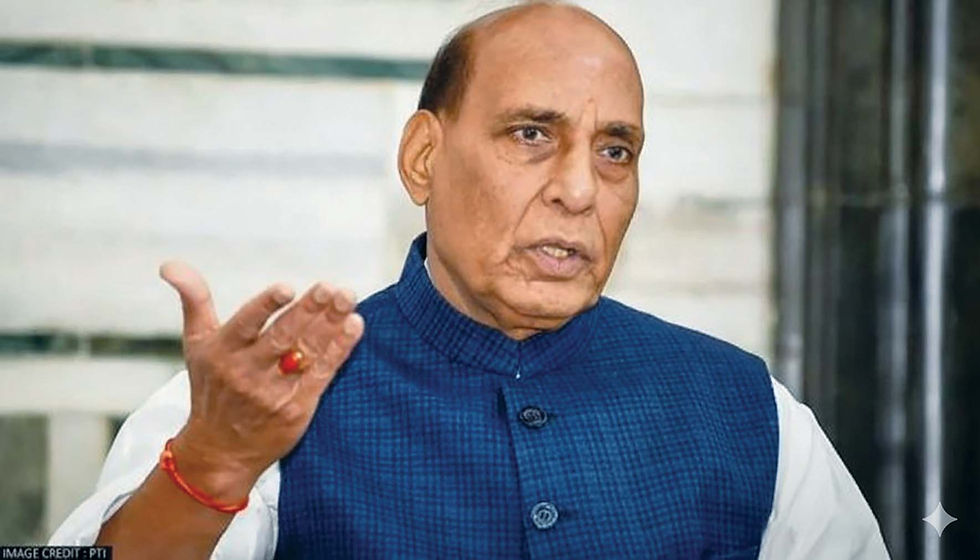Operation Sindoor: When Honour Struck Back
- Lt. Gen. K. Surendranath

- May 8
- 3 min read
With a codename steeped in grief and resilience, India’s retaliation fused firepower with moral clarity.

From the selection of targets and strategies to the symbolic and emotional significance of the codename, Operation Sindoor got it all right. It signalled to Pakistan that it can no longer harbour terror outfits and use them to engineer such brutal acts of terror in India with impunity. Operation Sindoor is hopefully just the tactical tip of our multidimensional strategic sword that will thrust deep into Pakistan to avenge decades of terrorist violence that has left thousands of widows in its wake. This is also the time for every patriotic Indian irrespective of religion, caste or creed to support our government to pursue their aim to put an end to such brutal inhumanity, and therefore, be prepared to pay the price to eradicate the scourge that has dogged our country for decades.
Strategic Rationale
Operation Sindoor was India’s calibrated response to the April 22 Pahalgam terror attack where 26 civilians were brutally murdered. Its purpose was to avenge this brutality, to dismantle the Pakistan-based terror infrastructure behind that massacre and to deter further incursions. The strikes were “focused, measured and non-escalatory,” attacking militants rather than conventional military forces. In strategic terms, this was a limited punitive strike – severe enough to punish the perpetrators, yet calibrated to avoid all-out war.
The planners identified nine terror camps - four in Pakistan’s Punjab and five in Pakistan-administered Kashmir. Notable targets included Jaish-e-Mohammed’s Bahawalpur training centre (Markaz Subhan Allah) and Lashkar-e-Taiba’s Muridke academy (Markaz Taiba), both jihadist training hubs. The strikes were launched simultaneously around 1 a.m. to maximize surprise. In keeping with the saying that revenge is a dish best served cold, nearly two weeks had passed since Pahalgam with no Pakistani action against those camps, effectively exhausting other options in the face of blatant Pakistani denial, before using force.
The operation leveraged India’s precision-strike arsenal with fighter jets carrying guided bombs and stand-off missiles. Official releases confirmed “missile strikes” on all targets and cited the use of “special precision munitions” to hit the camps accurately with minimal collateral damage.
Execution and Coordination: The strikes were executed with joint coordination. Fighter jets took off on schedule while naval and army assets supported the assault. All strike teams hit their objectives with precision, reflecting meticulous planning. Official statements noted the Army, Navy and Air Force acted in concert, and the Prime Minister was kept updated live through the night. The result was a clean execution where all designated sites were destroyed without Indian casualties reported.
Relatives of the Pahalgam victims praised the strikes as justice for their loved ones, and most political leaders backed the action. Internationally, leaders urged restraint and dialogue. The UAE’s foreign minister publicly called for de-escalation, and among others, Israel’s ambassador endorsed India’s right to self-defence. India’s response was widely viewed as measured and proportionate.
Pakistan immediately called the strikes an “act of war” and resorted to heavy shelling along the Line of Control. Pakistani media circulated claims of shooting down Indian fighter jets and hitting Indian bases, later debunked as misinformation. India’s military planners now anticipate tit-for-tat skirmishes or proxy attacks – but both sides know the nuclear threshold which may deter full-scale war. It is not judicious to further exam Pak retaliatory options in this open forum.
Symbolic Significance
Sindoor is the bright vermilion mark married Hindu women apply in their hair, symbolizing marriage. In Pahalgam, the attackers killed husbands in front of their wives, effectively “erasing the sindoor” of those women. By naming the mission Sindoor, India signalled it would avenge that injustice. The codename thus underscored the personal and cultural dimensions of India’s response to the cowardly brutal killing of husbands in front of their families and linking military action to the protection of our families and their honour.
In a utopian world, Pakistan would use this opportunity to stop fermenting terrorism and focus on building her economy by learning to live in peace with India. But that will require a regime change in Pakistan which, presently, is an unrealistic expectation.
(The author is a 1975 batch Armoured Corps officer who has commanded an Independent Armoured Brigade, an Infantry Division in Jammu and a Corps on the Chinese border. He also has had operational staff experience in J&K.)





Comments